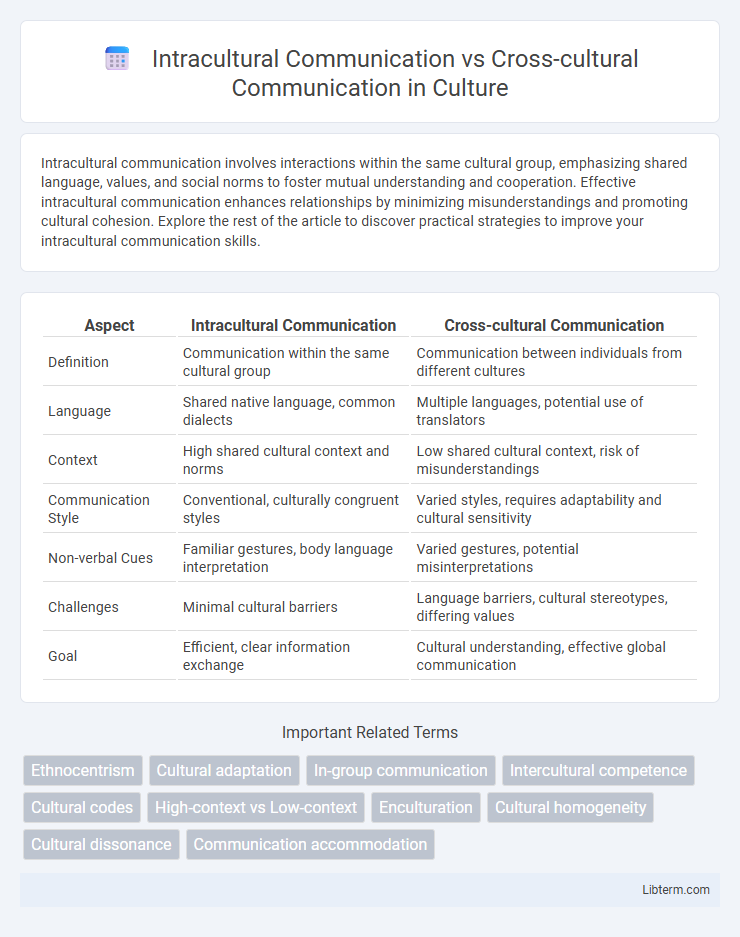Intracultural communication involves interactions within the same cultural group, emphasizing shared language, values, and social norms to foster mutual understanding and cooperation. Effective intracultural communication enhances relationships by minimizing misunderstandings and promoting cultural cohesion. Explore the rest of the article to discover practical strategies to improve your intracultural communication skills.
Table of Comparison
| Aspect | Intracultural Communication | Cross-cultural Communication |
|---|---|---|
| Definition | Communication within the same cultural group | Communication between individuals from different cultures |
| Language | Shared native language, common dialects | Multiple languages, potential use of translators |
| Context | High shared cultural context and norms | Low shared cultural context, risk of misunderstandings |
| Communication Style | Conventional, culturally congruent styles | Varied styles, requires adaptability and cultural sensitivity |
| Non-verbal Cues | Familiar gestures, body language interpretation | Varied gestures, potential misinterpretations |
| Challenges | Minimal cultural barriers | Language barriers, cultural stereotypes, differing values |
| Goal | Efficient, clear information exchange | Cultural understanding, effective global communication |
Introduction to Intercultural Communication
Intracultural communication occurs within a single cultural group, emphasizing shared norms, values, and language that facilitate mutual understanding and cohesion. Cross-cultural communication involves interaction between individuals from different cultural backgrounds, requiring awareness of diverse communication styles, beliefs, and social norms to avoid misunderstandings. Intercultural communication studies these dynamics to enhance effective dialogue and foster respect across varied cultural contexts.
Defining Intracultural Communication
Intracultural communication refers to the interaction between individuals who share the same cultural background, language, and social norms, enabling a deeper mutual understanding based on common cultural references. It emphasizes shared values, beliefs, and communication styles inherent within a single cultural group, influencing how messages are encoded and decoded. This form of communication contrasts with cross-cultural communication, which involves navigating differences between distinct cultural frameworks and adapting to diverse cultural norms.
Defining Cross-cultural Communication
Cross-cultural communication examines interactions between individuals from different cultural backgrounds, emphasizing the challenges and strategies for effective dialogue across diverse cultural norms. This field studies how language, customs, values, and communication styles vary worldwide, influencing mutual understanding and reducing misunderstandings in multicultural settings. Understanding cross-cultural communication is critical for global business, diplomacy, and international relations, where cultural competence enhances collaboration and conflict resolution.
Key Differences Between Intracultural and Cross-cultural Communication
Intracultural communication occurs within a single cultural group, emphasizing shared norms, values, and language that minimize misunderstandings, while cross-cultural communication involves interaction between individuals from different cultural backgrounds, often requiring heightened cultural sensitivity and adaptation. Key differences include the complexity of nonverbal cues interpretation, where intracultural communication benefits from common cultural reference points, whereas cross-cultural communication faces challenges due to diverse communication styles and potential stereotypes. Understanding these distinctions is crucial for improving interpersonal effectiveness and reducing cultural barriers in globalized environments.
Cultural Context and Communication Styles
Intracultural communication occurs within the same cultural context where shared norms, values, and communication styles create a common understanding, often relying on indirect or high-context communication in cultures like Japan or Arab countries. Cross-cultural communication involves interactions between individuals from different cultural backgrounds, requiring awareness of contrasting communication styles such as direct versus indirect speech or differences in nonverbal cues to avoid misunderstandings. Understanding the cultural context and adapting communication styles accordingly enhances clarity and effectiveness in both intracultural and cross-cultural exchanges.
Common Challenges in Intracultural vs Cross-cultural Exchanges
Intracultural communication often encounters challenges such as assumptions based on shared language and cultural norms, leading to overlooked nuances within the same cultural group. Cross-cultural communication faces significant obstacles including language barriers, differing values, and nonverbal misunderstandings that can hinder effective interaction. Both require heightened cultural awareness and adaptability to navigate complexities and avoid misinterpretations in exchanges.
Importance of Cultural Awareness
Intracultural communication involves interactions within the same cultural group, enhancing mutual understanding by deepening cultural awareness and reinforcing shared values. Cross-cultural communication occurs between individuals from different cultures, requiring heightened cultural sensitivity to navigate diverse norms and avoid misunderstandings. Developing cultural awareness in both contexts improves empathy, reduces conflicts, and facilitates effective collaboration in globalized environments.
Practical Examples of Intracultural Communication
Intracultural communication occurs within a single cultural group, often reflecting shared language, values, and norms, such as a team of Japanese employees collaborating on a project using culturally specific business etiquette. Cross-cultural communication involves interactions between people from different cultures, requiring awareness of diverse communication styles and potential misunderstandings. Intracultural scenarios include family discussions in a single ethnic community, local customer service interactions, and internal company meetings where cultural assumptions are homogeneous.
Practical Examples of Cross-cultural Communication
Cross-cultural communication involves interactions between individuals from different cultural backgrounds, such as a U.S. business executive negotiating with a Japanese partner, where understanding differing norms around hierarchy and decision-making is essential. Practical examples include adapting marketing strategies to local customs, like McDonald's offering vegetarian options in India, or using culturally sensitive language in international diplomatic talks to avoid misunderstandings. Effective cross-cultural communication requires awareness of cultural dimensions such as language nuances, nonverbal behaviors, and etiquette to bridge gaps and foster successful collaboration.
Strategies for Effective Communication Across Cultures
Intracultural communication strategies emphasize shared language, cultural norms, and nonverbal cues within a single culture, promoting clarity and mutual understanding. Cross-cultural communication requires adaptability, active listening, and cultural empathy to navigate differences in values, language barriers, and communication styles. Employing cultural intelligence and context awareness enhances effectiveness in both intracultural and cross-cultural interactions.
Intracultural Communication Infographic

 libterm.com
libterm.com